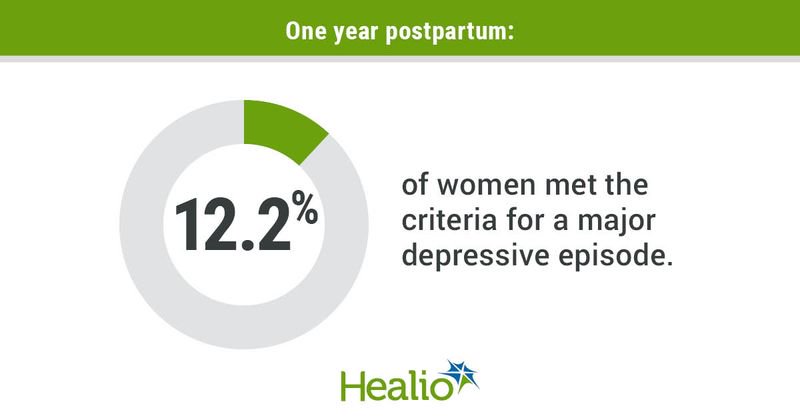Maternal depression linked with long-term economic instability
Depression after childbirth can affect the economic welfare and financial stability of mothers up to 15 years later, according to a study published in the American Journal of Preventive Medicine.
“The focus of my research is on the intersection of economics and maternal health. I am very interested in perinatal depression because it’s quite common, yet we still don’t know many things about its causes and effects on women and their families,” author Slawa Rokicki, PhD, an instructor in the department of health behavior, society and policy at the Rutgers School of Public Health, told Healio.

Prevalence of perinatal depression
According to the researchers, perinatal depression affects 13% of childbearing women in the United States. It has been linked to an increased risk of short-term economic insecurity, the researchers continued, although few studies have investigated its long-term financial outcomes.

“In the study, we were interested in long-term effects of postpartum depression because some previous literature had found strong links between maternal depression and childhood outcomes even up to age 18. However, few studies had looked at the impact on mothers themselves over that time span,” Rokicki said.
The researchers examined 4,362 women in the U.S. enrolled in the Fragile Families and Child Wellbeing Study who had delivered between 1998 and 2000 and were followed until 2017. Next, the researchers combined interview data with the mothers’ medical records and analyzed them at 3, 5, 9 and 15 years after delivery.
One year postpartum, 12.2% of the women met the criteria for a major depressive episode. Also, the women who experienced maternal depression in the year after giving birth were more likely to be born in the U.S., unmarried, have a lower household income and receive public assistance in the year before delivery.
Maternal depression during the first year had a strong and sustained association with economic hardship such as being unable to meet medical costs, utility shut-offs, inability to pay bills and food and housing insecurity, the researchers said, up to 15 years later. The researchers also found an association between maternal depression and unemployment in the first 3 years following delivery and poverty 3 to 9 years after delivery.
“I think what was particularly significant was the strength of the relationship between postpartum depression and economic outcomes in the long-term,” said Rokicki.
These strong relationships were found at each of years 3, 5, 9 and 15 years postpartum even after controlling socioeconomic and demographic factors, history of mental health challenges, health status, history of adversity and many other potential confounders, Rokicki said.
“It shows how important addressing perinatal depression is for the wellbeing of women and their families,” she said.
The need for screening
The researchers further said that their findings highlight the importance of screening and expanding access to mental health support services for low-income pregnant and postpartum women.
“From the health provider perspective, screening and treatment of perinatal depression is critical. Yet often women with the highest rates of perinatal depression have the lowest rates of screening and initiation of treatment,” Rokicki said.
“There is a high need for primary care and obstetric providers to educate women about perinatal mental health conditions early in pregnancy, conduct screening during pregnancy and postpartum, and to provide guidance on treatment,” she continued. “However, many primary care or obstetric providers do not have the training or capacity to screen and refer women to appropriate care.”
Despite having higher rates of maternal depression, the researchers added, racial and ethnic minority groups have the lowest rates of accessing care. Comprehensive interventions are needed to address the barriers to screening and treatment and reduce health inequities, they said.
Further, the researchers said their findings have implications for the cost-effectiveness of maternal health interventions, as programs designed to lower the prevalence of maternal depression should be viewed not only as interventions that promote population health but also as a means to increase economic well-being.
“There is strong evidence that counseling and supportive interventions for women at risk of depression are effective in preventing perinatal depression. However, there are several challenges in implementing preventive interventions, notably the serious gaps in screening rates and barriers to accessing mental health care,” Rokicki said.
Some state policies have attempted to address these gaps through universal screening or provider education, Rokicki said, but mental health continues to be insufficiently funded and underrecognized by policymakers.
“Furthermore, we still don’t have any guaranteed paid maternity leave, which is so important for emotional and physical support of new parents,” she said.
More studies would be helpful, Rokicki added.
“Examining this research question in other contexts, such as other high-income countries as well as low-income countries, would be very useful to understanding the social contexts and policies that may mitigate that relationship between maternal depression and long-term economic instability,” she said.
“Additionally, we are interested in understanding how differences in state health and economic policies such as paid family leave, unemployment and Medicaid eligibility impact on the risk of maternal depression and its economic effects,” she said.
Reference:
Rokicki S, et al. Am J Prev Med. 2021;doi:10.1016/j.amepre.2021.08.011.

